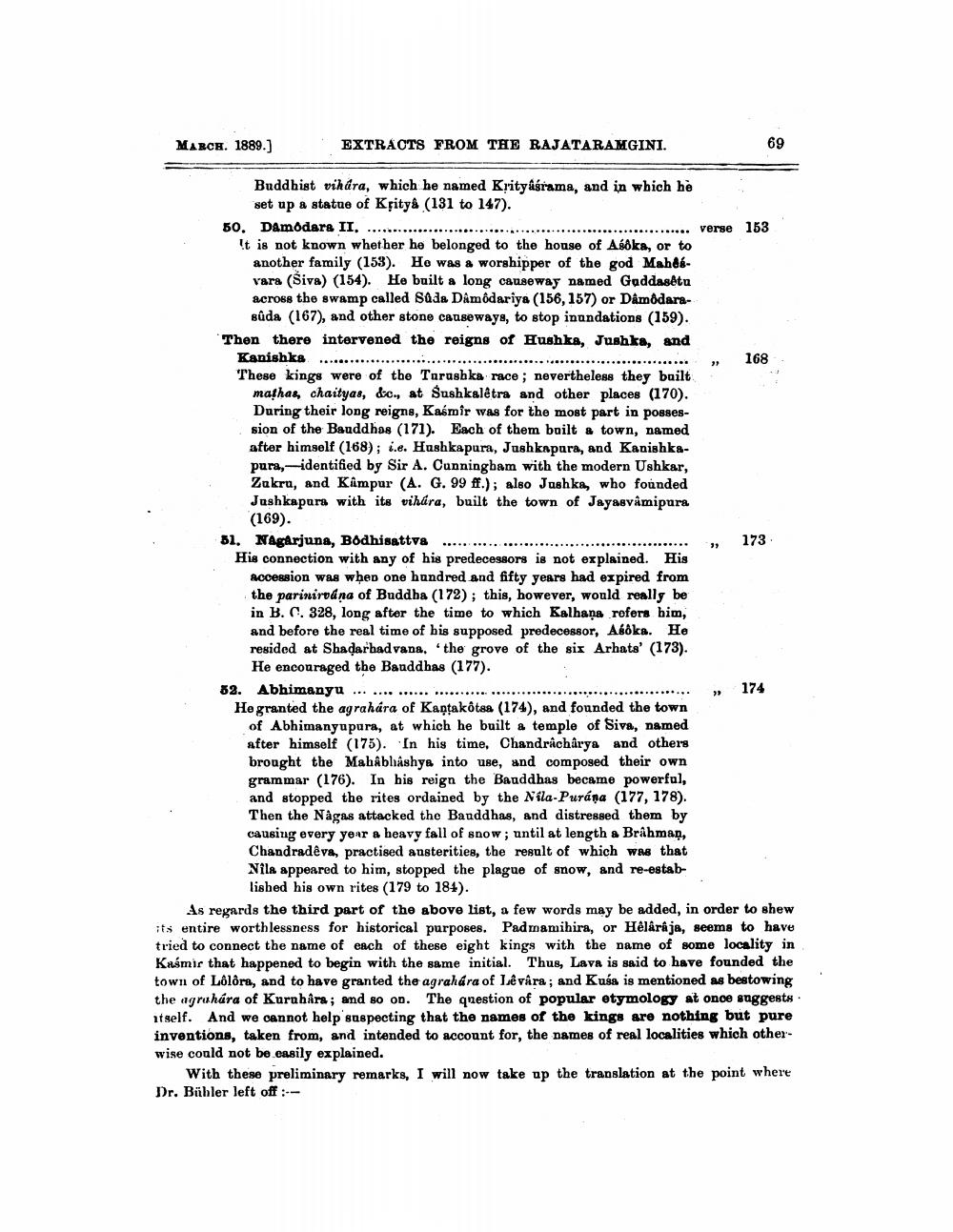________________
MABCH. 1889.)
EXTRACTS FROM THE RAJATARAMGINI.
69
Buddhist vihdra, which he named Krityasrama, and in which he
set up a statue of Ksitys (131 to 147). 50. Damodara II, ..
........... verse 153 It is not known whether he belonged to the house of Asoka, or to
another family (153). He was a worshipper of the god Mahdevara (Siva) (154). He built a long causeway named Guddasētu across the swamp called Sada Dámôdariya (156, 157) or Damodara
süda (167), and other stone causeways, to stop inundations (159). Then there intervened the reigns of Hushka, Jushka, and Kanishka ................
..... 168 These kings were of the Torashka race; nevertheless they built
mathas, chaityas, &c., at Sushkalêtra and other places (170). During their long reigns, Kaśmir was for the most part in possession of the Bauddhas (171). Each of them built a town, named after himself (168); 1.6. Hushkapura, Jushkapura, and Kanishkapura,-identified by Sir A. Cunningbam with the modern Ushkar, Zukru, and Kampar (A. G. 99 ff.); also Jushka, who founded Jushkapurt with its vihára, built the town of Jayasvâmipura
(169). 81. Nagarjuna, Bodhisattva ........................
.........
173 His connection with any of his predecessors is not explained. His
accession was when one hundred and fifty years had expired from the parinirvana of Buddha (172); this, however, would really be in B. C. 328, long after the time to which Kalhaņa refers him, and before the real time of his supposed predecessor, Abóka. He resided at Shadarbadvana. "the grove of the six Arhats' (173).
He encouraged the Bauddhas (177). 52. Abhimanyu ...............................................................
174 He granted the agrahára of Kantakôtsa (174), and founded the town
of Abhimanyupura, at which he built a temple of Siva, named after himself (175). In his time, Chandracharya and others brought the Mahâbhâshye into use, and composed their own grammar (176). In his reign the Bauddhas became powerful, and stopped the rites ordained by the Nila-Purána (177, 178). Then the Nagas attacked the Bauddhas, and distressed them by causing every year a heavy fall of snow; until at length a Brahman, Chandradêva, practised ansterities, the result of which was that Nila appeared to him, stopped the plague of snow, and re-estab
lished his own rites (179 to 184). As regards the third part of the above list, a few words may be added, in order to shew its entire worthlessness for historical purposes. Padmamihira, or Héláraja, seems to have tried to connect the name of each of these eight kings with the name of some locality in Kasmir that happened to begin with the same initial. Thus, Lava is said to have founded the town of Lôlôra, and to have granted the agrahára of Lê våra ; and Kusa is mentioned as bestowing the agruhára of Kuruhårs; and so on. The question of popular etymology at once suggests itself. And we cannot help suspecting that the names of the kings are nothing but pure inventions, taken from, and intended to account for, the names of real localities which otherwise could not be easily explained.
With these preliminary remarks, I will now take up the translation at the point where Dr. Bühler left off :--




